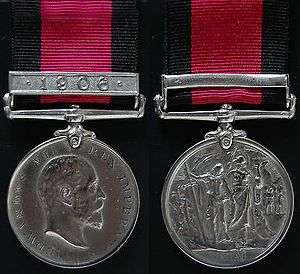Natal Native Rebellion Medal
| Natal Native Rebellion Medal | |
|---|---|
 | |
| Awarded by the Monarch of the United Kingdom and the British Dominions, and Emperor of India | |
| Country |
|
| Type | Military campaign medal |
| Eligibility | Military and police forces |
| Awarded for | Campaign service |
| Campaign | Bambatha Rebellion, 1906 |
| Clasps | 1906 |
| Statistics | |
| Established | 1907 |
| First awarded | 1907 |
| Total awarded | 9,622 |
| Order of wear | |
| Next (higher) | Tibet Medal |
| Next (lower) | India General Service Medal (1909) |
|
Ribbon bar | |
The Natal Native Rebellion Medal was a British campaign medal. It was authorised in 1907 for service in Natal during a Zulu revolt against British rule and taxation in 1906. The 1906 Clasp to the medal was awarded to those who had served for more than fifty days.[1][2][3]
The Bambatha Rebellion
In the years following the Second Boer War, British employers in Natal found it difficult to recruit sufficient Zulu farm workers because of increased competition from the gold mines on the Witwatersrand. To coerce more Zulu men to enter the labour market, the Natal Colonial government introduced a £1 head tax, in addition to the existing hut tax. The revolt, led by Chief Bambatha kaMancinza, leader of the amaZondi clan of the Zulu people who lived in the Mpanza Valley, a district near Greytown, was sparked in February 1906, when two British tax collectors were killed near Richmond.[4]
Martial law was declared and Bambatha embarked on a series of guerrilla attacks, using the Nkandla forest as a base. The revolt continued until colonial troops managed to surround the rebels at Mome Gorge. Between 3,000 and 4,000 Zulus were killed during the revolt, some of whom died fighting on the side of the Natal government. More than 7,000 were imprisoned, and 4,000 flogged. King Dinuzulu kaCetshwayo, who gave tacit support to Bambatha, was arrested and sentenced to four years imprisonment for treason.[4]
Institution
The Natal Native Rebellion Medal and the 1906 Clasp to the medal were authorised by King Edward VII on 9 May 1907, as a campaign medal for service during the Bambatha Rebellion in Natal in 1906.[1][2][3]
Award criteria
To qualify for the medal, a soldier or policeman had to have served in the field for at least twenty days between 11 February 1906 and 3 August 1906. Those who had served for fifty days or longer, which most recipients did, qualified for the award of the 1906 Clasp to the medal.[1][2][3]
Altogether 9,622 medals were awarded. Most of the recipients were members of the Natal colonial military and police forces, while 546 medals were awarded to volunteers from the Transvaal Colony and 70 medals to troops from the Cape of Good Hope.[1][2][3]
Order of wear
Campaign medals and stars are not listed by name in the order of wear prescribed by the British Central Chancery of the Orders of Knighthood, but are all grouped together as taking precedence after the Queen's Medal for Chiefs and before the Polar Medals, in order of the date of the campaign for which awarded.[5]
In the order of wear of British campaign medals, the Natal Native Rebellion Medal takes precedence after the Tibet Medal and before the India General Service Medal (1909).[5]
South Africa
With effect from 6 April 1952, when a new South African set of decorations and medals was instituted to replace the British awards used to date, the older British decorations and medals applicable to South Africa continued to be worn in the same order of precedence but, with the exception of the Victoria Cross, took precedence after all South African orders, decorations and medals awarded to South Africans on or after that date. Of the official British campaign medals which were applicable to South Africans, the Natal Native Rebellion Medal takes precedence as shown.[5][6][7]
![]()
![]()
![]()
- Preceded by the King's South Africa Medal.
- Succeeded by the 1914–15 Star.
Description
- Obverse
The medal was struck in silver and is a disk, 36 millimetres in diameter. The obverse depicts the uncrowned head of King Edward VII, surrounded by the legend "EDWARDVS VII REX IMPERATOR" around the perimeter.[1][2][3]
- Reverse
The reverse displays the figures of Britannia and Natalia against a background of a landscape with Zulu huts. The name "NATAL" appears in the exergue.[1][2][3]
- Clasp
The clasp displays the year "•1906•".[1][2]
- Ribbon
The ribbon is 32 millimetres wide and crimson, with 7 millimetres wide black edges.[1][2]
References
- 1 2 3 4 5 6 7 8 Alexander, E.G.M., Barron, G.K.B. and Bateman, A.J. (1986). South African Orders, Decorations and Medals. Human and Rousseau.
- 1 2 3 4 5 6 7 8 Mitchell, F.K. (1965). The Natal Native Rebellion 1906 War Medal in South African Numismatic Journal, April 1965.
- 1 2 3 4 5 6 South African Medal Website - Colonial Military Forces (Accessed 6 May 2015)
- 1 2 Stuart, J. (1913). History of the Zulu Rebellion 1906. London: Macmillan and Co. pp. 548–581.
- 1 2 3 The London Gazette: (Supplement) no. 56878. p. 3352. 17 March 2003.
- ↑ Government Notice no. 1982 of 1 October 1954 - Order of Precedence of Orders, Decorations and Medals, published in the Government Gazette of 1 October 1954.
- ↑ Republic of South Africa Government Gazette Vol. 477, no. 27376, Pretoria, 11 March 2005, OCLC 72827981